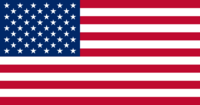United States of America
The United States of America, also known as the United States or America, is a nation located in North America, bordering both the North Atlantic Ocean and the North Pacific Ocean, between Canada and Mexico. The current head of state is President George W. Bush, serving from 2001 and will step down in 2009.
Geography
Climate
The climate is diverse in the United States, but many parts have a continental climate, often with hot summers and great variations in temperature during a year.
The west coast has a maritime climate, with relatively mild winters. There is however a big difference between the northern and southern parts of the west cost. The northern parts receive a lot of precipitation, especially during the fall. The southern and central parts of California have a typical Mediterranean climate, with very little precipitation and sun most of the year. One of the warmest areas of the world, Death Valley, is located in Southern California.
East of the Rocky Mountains are the Great Plains. This area consists of large steppes, having a unique climate. Moist winds from the Gulf of Mexico meet cold wind from the north, which leads to a lot of changing weather. The Great Plains are known for their tornadoes, and for snow and hail storms. The Midwest is known for short springs and falls, and often long winters.
The climate is mostly warm in the southern states along the Gulf, and there is hardly any real winter. The south often sees hurricanes in the fall, causing great damage.
The climate is more varied on the east coast and in the Appalachian Mountains, but a common denominator is that these areas often receive lot of precipitation. The climate of the east coast is to a lesser degree than he west coast affected by the ocean, so that is has a typical continental climate. The northeastern parts of the United States have a lot of snow in the winter, including the coastal areas.
History
Thirteen of Britain's American colonies broke with the mother country in 1776 and were recognized as the new nation of the United States of America following the Treaty of Paris in 1783. During the 19th and 20th centuries, 37 new states were added to the original 13 as the nation expanded across the North American continent and acquired a number of overseas possessions. The two most traumatic experiences in the nation's history were the Civil War (1861-65) and the Great Depression of the 1930s. Buoyed by Allied victories in World Wars I and II and the end of the Cold War in 1991, the U.S. remains the world's most powerful nation-state. The economy is marked by steady growth, low unemployment and inflation, rapid advances in technology, and a very wide range of incomes, compared to other nation-states.[1][2]
